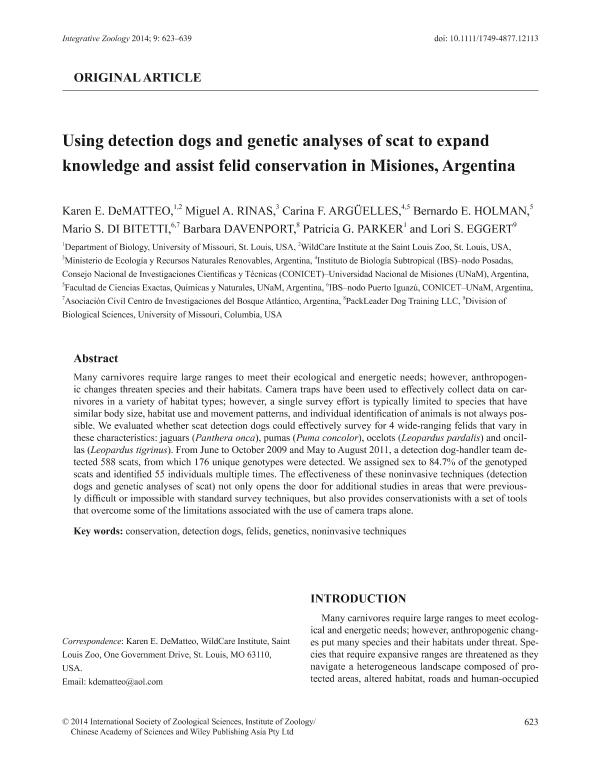Artículo
Using detection dogs and genetic analyses of scat to expand knowledge and assist felid conservation in Misiones, Argentina
Dematteo, Karen; Rinas, Miguel A.; Argüelles, Carina Francisca; Holman, Bernardo E.; Di Bitetti, Mario Santiago ; Davenport, Barbara; Parker, Patricia G.; Eggert, Lori S.
; Davenport, Barbara; Parker, Patricia G.; Eggert, Lori S.
 ; Davenport, Barbara; Parker, Patricia G.; Eggert, Lori S.
; Davenport, Barbara; Parker, Patricia G.; Eggert, Lori S.
Fecha de publicación:
11/2014
Editorial:
International Society of Zoological Sciences
Revista:
Integrative Zoology
ISSN:
1749-4869
e-ISSN:
1749-4877
Idioma:
Inglés
Tipo de recurso:
Artículo publicado
Clasificación temática:
Resumen
Many carnivores require large ranges to meet their ecological and energetic needs; however, anthropogenic changes threaten species and their habitats. Camera traps have been used to effectively collect data on carnivores in a variety of habitat types; however, a single survey effort is typically limited to species that have similar body size, habitat use, and movement patterns and individual identification of animals is not always possible. We evaluated whether scat detection dogs could effectively survey for four wide-ranging felids that vary in these characteristics: jaguar (Panthera onca), puma (Puma concolor), ocelot (Leopardus pardalis), and oncilla (Leopardus tigrinus). From June to October 2009 and May to August 2011, a detection dog-handler team detected 588 scats, from which 176 unique genotypes were detected. We assigned sex to 84.7% of the genotyped scats and identified 55 individuals multiple times. The effectiveness of these noninvasive techniques (detection dogs and genetic analyses of scat) not only opens the door for additional studies in areas that were previously difficult or impossible with standard survey techniques, but also provides conservationists with a set of tools that overcome some of the limitations associated with the use of camera traps alone.
Palabras clave:
CONSERVATION
,
DETECTION DOGS
,
FELIDS
,
GENETICS
,
NONINVASIVE TECHNIQUES
Archivos asociados
Licencia
Identificadores
Colecciones
Articulos(IBS)
Articulos de INSTITUTO DE BIOLOGIA SUBTROPICAL
Articulos de INSTITUTO DE BIOLOGIA SUBTROPICAL
Citación
Dematteo, Karen; Rinas, Miguel A.; Argüelles, Carina Francisca; Holman, Bernardo E.; Di Bitetti, Mario Santiago; et al.; Using detection dogs and genetic analyses of scat to expand knowledge and assist felid conservation in Misiones, Argentina; International Society of Zoological Sciences; Integrative Zoology; 9; 5; 11-2014; 623-639
Compartir
Altmétricas



